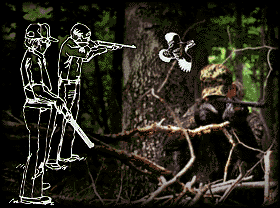

Years later I would watch Robert DeNiro sum up the Vietnam experience by letting a deer prance offscreen in The Deer Hunter. What I had in common with the DeNiro character was a small-town, rural background where hunting was the rule, not the exception--and coming of age during the Vietnam War.The fact that I had friends and relatives in the war was affecting the joy of my hunt. The prospect of my joining them was ruining it. So I stopped. I did some "hypothetical hunting," going after a shot and not taking it, but that wore thin. I was just confusing the issue.
I didn't get drafted, and I didn't hunt again for over 20 years. In the urban areas where I lived, I didn't come in contact with hunters and didn't think a lot about it.
Instead I concentrated on my artwork: my lifelong project to push the boundaries of art, in the "social sculpture" tradition of people like Joseph Beuys in Germany, who worked during the '50s and '60s. Beuys' use of unorthodox materials such as felt and fat in sculpture came out of his horrifying, violent experiences during WWII. Likewise, it's the experience dictating the art material/product that's paramount in my series of projects. During the two decades that I didn't hunt, my art projects included starting a rock band and establishing a church. In the early '80s I bought a cow, and before it eventually got hit by a truck, I branded it, took prints off its nose and so on.This, as it happens, is how I came back to hunting a few years ago: through my art. I'd been covering paintings with colored felt "skins" and "skinning" the covers from books and using them as canvas. The transition to real pelts was smoother than I expected.